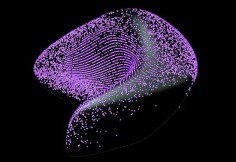MIT MOBILE EXPERIENCE LAB
the cloud
source: designboom
the cloud
an organic sculptural landmark that responds to human interaction and expresses context awareness using hundreds of sensors and over 15,000 individually addressable optical fibers. constructed of carbon glass, spanning over four meters, and containing more than 65 kilometers of fiber optics, the cloud encourages visitors
to touch and interact with information in new ways, manifesting emotions and behavior through sound and a dichotomy of luminescence and darkness.
located in downtown florence outside the fortezza da basso. the cloud is part of the ‘redesigning fashion trade shows’ project that pitti immagine launched with MIT mobile experience lab in 2007. it is a long-term project that will creatively rethink the trade show concept and will propose innovative technologies, perspectives and
sensory experiences for fashion trade shows.
the shape
the shape of the cloud originates from a plastic movement in space that is frozen in time, a still image capturing an instant of a volume in motion. the cloud’s form is continuous and soft, its curvaceous, seductive and yet intriguing. it was designed to be seen both from inside and outside, so it turns on itself revealing a convex
curved surface to the exterior while embracing the interior space of the pavilion with its internal concave shape. the cutting edge design techniques used in our process allowed defining continuous curved surfaces, which respond to varying modeling forces, which result in the final gesture of the cloud, as a liquid mass emerging from
the ground and free-floating in space. the surface treatment is of a highly polished gloss, as the cloud displays at the same time that it reflects its environment, it becomes a witness of the space and it inhabitants. the cloud reflects its surroundings as it reacts to it.
fiber distribution
distribution of the fibers along the surface of the cloud responds to its curvaceous nature. its organic form is accentuated by a non homogeneous gradual distribution of fibers, offering areas of high density for a higher resolution display, to areas of low or minimal density to maximize the softness and reflective qualities of the surface. the distribution of the fibers was algorithmically designed to match both the sensing capabilities of the cloud and its display properties. each fiber is a three-dimensional pixel located freely in space, in a spatial configuration, therefore the distribution of them is both aesthetical as it is functional. the distribution pattern of the cloud was thought as a platform which could offer the possibility of extending its current functionalities and interaction capabilities.
sensors
the cloud is equipped with 20 proximity sensors that cover the entire object. It can detect if someone is near the object, but also the direction they move, if they go to the back of the object, if they are walking around, etc. three-quarters of the cloud are covered with touch sensors for precise touch-area tracking. besides that, the cloud is equipped with two cameras and microphones for long range detections.
nearby interaction
the cloud is capable of detecting presence and engaging with users through its multi-fiber touch interface. tactile engagement with the individual fibers provokes a variety of responses from the cloud, ranging from ambient lighting to animation and sound. the cloud’s open-source development platform encourages users to contribute to a growing library of creative interactions that will stretch the limits of the imagination.
.
.
.
.
.
.
.
source: mobilemitedu
We seek to radically reinvent and create connections between people, information, and places. By operating within the vibrant atmosphere of MIT, the Mobile Experience Lab drives innovation by thoughtfully considering the relationship between emerging technologies and their surrounding social, cultural, and physical spaces.
In order to accomplish this, we conduct both academic and field research, design elegant and simple solutions to problems, and test our ideas through physical and digital prototypes to ensure that our ideas withstand real world issues.
.
.
.
.
.
.
.
source: newsland
Это так называемое «Облако» является разработкой экспериментальной лаборатории MIT и оно действительно заслуживает внимание. Эта огромная интерактивная скульптура или «псевдоорганическая форма жизни», как ее называют создатели, сделана из оптоволокна (общей длиной 65 км!) и буквально напичкана датчиками движения. На приближение и движения человека скульптура будет реагировать изменениями цветов, звуков и разной анимацией. Все это должно иметь прямо таки гипнотическое воздействие. Конечно, такое лучше один раз увидеть, чем сто раз услышать, так что обязательно смотрите видео далее или, если будете в ближайшее время в Флоренции, сможете увидеть это Облако вживую.
.
.
.
.
.
.
.
source: blogdonews
最近MIT Mobile Experience Lab推出了名为The Cloud的电子互动雕塑,该雕塑的最大特点是全部采用光学纤维和碳化玻璃制成,可感知人在外界的动作而产生不同的反应,包括改变自身颜色、图案和声音,同时,这个雕塑所采用的软件也是开源的,这意味着任何人都可以向其中添加具有创意的互动效果。
The Cloud最大宽度为4米,使用了总长为65公里的15,371根独立光学纤维。该雕塑目前坐落在意大利的佛罗伦萨市中心,是“Redesigning Fashion Trade Shows”的一部分(这个长期项目由MIT Mobile Experience Lab和Pitti Immagine 共 同在去年1月份发起,旨在推广应用于创意设计的各种科技)。The Cloud上面的20个接近传感器不但能够感知是否有人靠近雕塑,还能感知人体的移动方向(比如走向雕塑的背面或者来回走动等等),另外,占据表面四分之 三面积的触摸传感器是提供精确触摸定位的关键所在。


